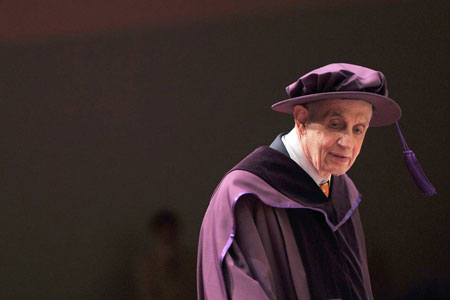John Nash, a Nobel laureate and mathematical genius whose struggle with mental illness was documented in the Oscar-winning film “A Beautiful Mind”, was killed in a car accident on Saturday. He was 86. The accident, which occurred when the taxi Nash was traveling in collided with another car on the New Jersey Turnpike, also claimed the life of his 82-year-old wife, Alicia. Neither of the two drivers involved in the accident sustained life-threatening injuries.
上周六,奥斯卡获奖影片《美丽心灵》主人公的原型、美国数学天才、诺贝尔奖得主约翰•纳什遭遇车祸去世,终年86岁。事故发生时,纳什夫妇乘坐的一辆出租车在新泽西高速路上与另外一辆汽车相撞,纳什82岁的妻子艾丽西亚也在车祸中遇难。出租车司机以及对方车辆的司机都没有遭受致命伤。

Born in West Virginia in 1928, Nash displayed an acuity for mathematics early in life, independently proving Fermat’s little theorem before graduating from high school. By the time he turned 30 in 1958, he was a bona fide academic celebrity. At Princeton, Nash published a 27-page thesis that upended the field of game theory and led to applications in economics, international politics, and evolutionary biology. His signature solution—known as a “Nash Equilibrium”—found that competition among two opponents is not necessarily governed by zero-sum logic. Two opponents can, for instance, each achieve their maximum objectives through cooperating with the other, or gain nothing at all by refusing to cooperate. This intuitive, deceptively simple understanding is now regarded as one of the most important social science ideas in the 20th century, and a testament to his almost singular intellectual gifts.
1928年,纳什出生在美国西佛吉尼亚州。他很早就表现出出色的数学天赋,高中还未毕业就已经独立证明了费马小定理。1958年,而立之年的纳什已是名副其实的学术界名人。在普林斯顿,纳什一篇27页的论文颠覆了博弈论领域,博弈论此后被广泛应用于经济学、国际政治以及进化生物学领域。著名的解决方案“纳什均衡”就是由他发现并以他的名字命名。“纳什均衡”指博弈双方不一定受到零和逻辑的约束,比如,博弈双方可以通过合作均取得最大收益,或者不合作承担零收益(但也没有损失)。这表面看来似乎很好理解的理论却已经成为20世纪最重要的社会学观点之一,而这也是纳什卓越智慧的明证。
But in the late 1950s, Nash began a slide into mental illness—later diagnosed as schizophrenia—that would cost him his marriage, derail his career, and plague him with powerful delusions. Nash believed at various times that he was the biblical figure Job, a Japanese shogun, and a “messianic figure of great but secret importance.” He obsessed with numbers and believed The New York Times published coded messages from extraterrestrials that only he could read.
但是,自1950年代末,纳什开始受到精神疾病的折磨,经诊断他患上了精神分裂症。他因此离婚,事业毁于一旦,他自己也饱受幻觉的折磨。他时而以为自己是圣经中的约伯,时而把自己当做日本古代的将军,时而又以为自己是“隐秘而伟大的救世主”。他沉溺于数字之中,坚信《纽约时报》中藏匿着外星人留下的密码,而只有他才能解开。
Mental institutions and electroshock therapy failed to cure him, and for much of the next three decades, Nash wandered freely on the Princeton campus, scribbling idly on empty blackboards and staring blankly ahead in the library. Atlantic contributor Robert Wright, an undergraduate at Princeton in the late 1970s, remembers Nash as “some math genius that went crazy” who wore colorful sneakers and quietly watched people. His schizophrenia removed him completely from his work. By the time Nash was awarded the Nobel prize in Economics in 1994 (along with John Harsanyi and Reinhard Selten), he hadn’t published a paper in 36 years.
精神病院、电击疗法都没能治愈纳什。在随后的三十年间,他游荡在普林斯顿的校园里,或在空黑板上“涂鸦”,或在图书馆中发呆。《大西洋月刊》撰稿人罗伯特•赖特是普林斯顿1970年代的毕业生,他回忆到:这位“疯了的数学天才”总是穿着彩色的运动鞋,安静地看着人来人往。精神分裂让他完全无法工作,直至1994年(与约翰•海萨尼 、莱因哈德•泽尔腾共同)获得诺贝尔经济学奖的36年间,纳什再无论文发表。
But like a child cured of a nightmare by the switch of a light, Nash recovered from his illness seemingly by choosing not to be sick anymore. “I emerged from irrational thinking, ultimately, without medicine other than the natural hormonal changes of aging,” he wrote in 1996. Five years later, the release of the film A Beautiful Mind, based on Sylvia Nasar’s 1998 book of the same name, amplified Nash’s extraordinary life story to an international audience. He continued to work, travel, and speak at conferences for the rest of his life.
就像打开灯就能让孩子走出梦魇一般,决定不再做病人后纳什似乎就自己摆脱了病魔。1996年,他写到:“最终,我摆脱了妄想,不是依靠药物,而是随着年纪见长体内激素自然而然发生了变化。”5年后,根据1998年西尔维娅•娜萨同名小说改编的电影《美丽心灵》上映,纳什与众不同的故事为全世界观众所知。而故事的主人公在接下来的人生中依旧继续工作、旅行、在大大小小的会议上发言。
It’s tempting to wonder what Nash might have accomplished had mental illness not robbed him of so many productive years. But the “beautiful mind” that gave him such prodigious mathematical talent was indivisible from the one which spawned powerful delusions. In her study of creativity published in the July/August 2014 edition of the Atlantic, Nancy Andreasen related a memorable anecdote from Nasar’s book. Upon visiting Nash at a mental institution, a colleague asked how a man so devoted to reason and logical truth could believe that extraterrestrials were sending him messages.
人们也许不禁想问,如果没有这么多年精神疾病的困扰,纳什又将取得怎样的成就?他的美丽心灵既带给了他巨大的数学成就,同时也让他饱受幻觉的折磨。《大西洋月刊》7/8月刊中,南希•安卓森关于创造力的一篇文章就提到了娜萨书中一个令人难忘的故事:纳什的一个同事去精神病院看望他时,曾问他,身为一个如此执着于理性与逻辑真理的人,他为何会相信外星人传递信息这种事。
“Because the ideas I had about supernatural beings came to me the same way that my mathematical ideas did,” replied Nash. “So I took them seriously.”
纳什答道:“因为那些关于超自然生物的想法向我袭来,就仿佛曾经的那些数学观点一样。于是,我当真了。”













